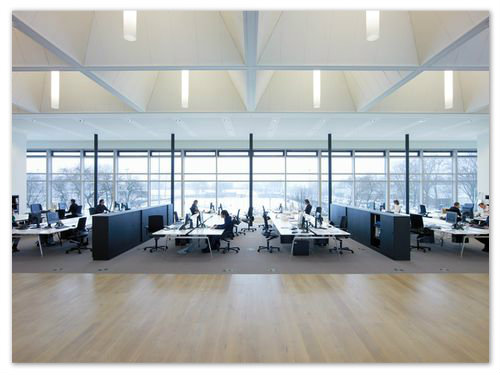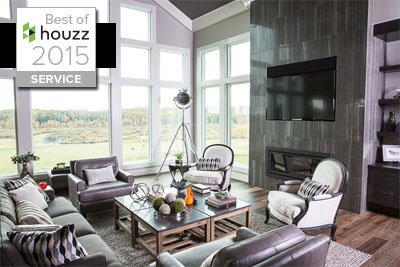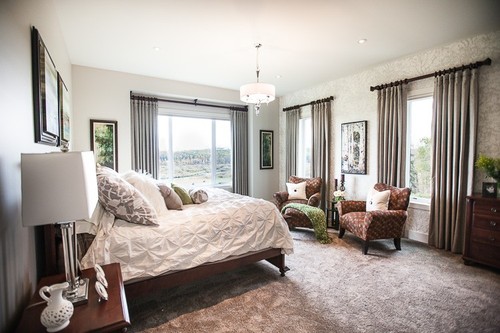Everyone is affected by the amount of daylight- or lack of, that we have in our workplaces. It can affect your brain, mood, health and productivity, both at work and at home. Here are some of the things that you need to know about light and what it does for you, your employees, and your bottom line..
1. Benefits of Natural Light
When you get enough sunlight (duration and intensity) it enhances your mental and physical well-being by triggering serotonin production in your brain. This is the neurotransmitter/hormone that is responsible for a stable positive mood as well as a feeling of well-being and calm. Natural light can have a positive effect on your productivity. People who sit near windows are on task more than people who sit far from windows. They spend more hours of the day being on task and effective than people in interior cubicles. When we have daylight we are more alert and focused. Combining sunlight with nature such as views of sky, grass and trees further increases job satisfaction. When we have a view of nature, we are less frustrated at work, more enthusiastic about what we’re doing, in better physical health and are more satisfied with our lives in general.
2. Natural Light Cycle and Your Circadian Rhythm
Controlling perceived light levels in an office during the day to mimic the natural light cycle helps keep your circadian rhythm in sync. This improves your quality of sleep, creativity and the ability to maintain focus. Daylight harvesting systems can help control light levels in your space. One method of controlling these light levels is to use a daylight switching device. Auto-on/auto-off devices can be incorporated in, or linked to, a photo sensor so that lighting is only switched on automatically when there is insufficient daylight to meet the specified luminance. Alternatively, the control can be linked to a manual switch so lighting is on only when you turn it on. These methods not only help your employees maintain their natural circadian rhythm (making them more productive), but have the added effect of significantly reducing your energy costs.
3. Using Artificial Light– the Right Way
The amount of artificial light used in a work space has as much influence on how we perform as the amount of daylight. Both indirect and direct lighting increases energy levels in an office. Brightly lit rooms feel more cheerful, which boosts the mood of the people in that space. Combining daylight with controlled task lighting and indirect ambient lighting(ceiling fluorescents that mimic daylight, desktop task lighting, pot lighting, reflective low gloss wall, ceiling and furnishing finishes) is comforting and healthy for you and is associated with higher productivity levels.
4. How a Designer can Help
There are many ways a designer can help you incorporate effective healthy light into your space. These include:
- using large windows – the bigger and closer to you the better
- interior glass walls and doors
- light shelves
- horizontal blinds
- light wells
- skylights
- clerestories
Having interior glass walls and doors helps move light deeper into the interior of a building. Interior light shelves act as a solar shading product, as well as a solar reflector by gathering natural daylight at the window and redirecting it farther into the interior of the room. Horizontal blinds help to reflect light and reduce glare when they are tilted in different positions. Light wells which are light pipes in ceilings have a reflective interior coating and translucent cover and they direct light into the room. Skylights which are installed on rooftops also spread light into the interior. Clerestories are usually a band of windows at roof top level and help move natural light deeper into the interior of a building.
All of these help move light into a space, effectively and cheaply, by reducing the need for artificial lighting during peak daylight hours. However, glare can sometimes be a problem in these daylight spaces. Transparent window coatings, computer monitor covers and shades or blinds can help eliminate glare without hampering view and distorting the colors of sunlight.
5. Don’t be SAD
On the negative side, Seasonal Affective Disorder (SAD) is a condition that can be hard on many people. It tends to be worse in northern regions and around coastal areas (Great Lakes, western British Columbia, etc.) during the winter. SAD is prevalent anywhere there is a limited amount of bright sunlight due to short days in the winter, persistent overcast conditions or a combination of both. Yet, the lack of the healthy light can affect you even if you don’t have the full blown disorder. Everyone is affected by the amount of natural light they get in a day. If you are not getting enough natural light, your energy level can go down, your mood can be more irritable, you are far less productive, your sleep is affected, and you tend to have more health problems. All this translates into lost time, lower productivity and poor morale – which leads to turnover, less creativity and a reduced bottom line. Particularly at risk are shift workers and those who work mostly at night or in the interior of buildings – away from windows and other natural light sources.
By having a designer incorporate healthy lighting into your work place, you can avoid these issues for yourself and your employees while enjoying all the benefits listed earlier, with less employee turnover and a much more pleasant space to work.
Ellen Walker, one of Canada’s premier commercial interior consultants, provides a full range of design services that enhance employee productivity and health, and address each company’s long term needs and challenges.
Dr. Ganz Ferrance holds a Ph.D in Psychology and has been helping individuals and organizations reduce their stress and enjoy more success for over 20 years. He is a favorite of the media and has been interviewed several times by The Edmonton Journal, CBC Radio, Good Morning Canada, and CTV News. He has been a regular health panel expert on Alberta Primetime for over 2 years and has been presenting a monthly segment on CTV’s Noon News for the past 7 years. You can learn more about “Dr. Ganz” and view some of tips from his TV appearances at DrGanzFerrance.com or give him a call at 780-428-5433.









